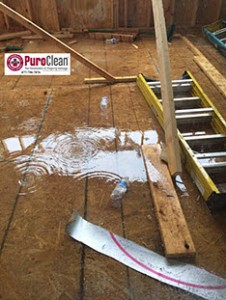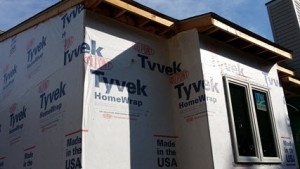[vc_row][vc_column width=”1/3″][vc_column_text]


[/vc_column_text][/vc_column][vc_column width=”2/3″][vc_column_text]Let’s say you’re a homeowner. And let’s say due to the volatility in the stock market you’ve decided to take your investment money out of the market and build an addition to your home.
You contact an architect, then get 3 quotes for the new construction. You choose the lowest bid thinking you’ll get the biggest bang for your buck.
It takes 3 months, but once completed the new addition looks beautiful.
Until you notice a musty odor. And then you notice mold growing on your newly painted walls.
You call us for a mold inspection and we find several areas of moisture: walls, floors, and ceiling. We remove a section of drywall and find the OSB sheathing covered in black mold. We peel back the new carpet and pad and find mold growing on the OSB subfloor.
And you wonder “how could this happen?”
There’s a 2-part answer to that question: 1. flaws in design that allow water to enter the new construction; and 2. flaws in construction practice that allow water to dwell in the building materials.
But how does water cause mold to grow after new construction?[/vc_column_text][/vc_column][/vc_row][vc_row][vc_column][vc_column_text]Oriented Strand Board (OSB) is an engineered, mat-formed panel product made in 3 layers. Strands, flakes or wafers sliced from pieces of wood are bonded together with an inner and outer layer under heat and pressure.
The great thing about using OSB in construction is the cost savings: OSB is much cheaper than plywood or wood planking.
So what’s the problem with OSB?
The resin bonding material that holds the wood chips together is water resistant and boil-proof. But the operant word here is “water resistant” – not water proof! The panels can only resist moisture in dry service conditions.
Because OSB is a cellulose-based material, it already contains mold spores. The spores only require moisture and a little time to trigger their growth.
When OSB board is used in construction and gets soaked with rain, it takes time, the right equipment, and the right knowledge to get it dry to prevent mold after construction.
Unfortunately, a lot of contractors don’t appreciate just how hard it is and how long it will take to dry all three layers of OSB once it gets wet.
Because OSB holds moisture inside the layers, it can look and feel dry on the outside. But, a lot of water is still trapped in the middle. Without meters to measure the moisture, a lot of contractors proceed to install drywall over wet OSB because it “looks dry.”
Then, the outside of the addition gets sealed to make it energy efficient. Unfortunately, this practice traps the moisture hidden in the OSB in the walls and mold proceeds to grow.
The best way to prevent mold after construction is by starting with the right materials and the best construction methods, and to build in as much opportunity for ventilation as possible.
So here are our 2 tips for homeowners to help you prevent mold after construction:
1. Talk to your building contractor about the possibility of using mold-resistant materials.
There are other options! For example, drywall is available without the traditional paper covering – one of the biggest contributors to hidden mold growth.
There are also mold-resistant plaster and paints. These products contain a fungicide to keep mold from growing on surfaces.
And there’s even mold-resistant lumber which is impregnated with fungicides.
But remember: mold-resistant building materials are more expensive.
And, even though they’re mold resistant, they can’t overcome basic design and construction flaws that trap moisture inside the walls of your new addition.
Mold resistant building materials have to be installed properly, according to manufacturer directions for them to be effective.
[/vc_column_text][/vc_column][/vc_row][vc_row][vc_column width=”1/2″][vc_single_image image=”9271″ img_size=”large” style=”vc_box_border” border_color=”black” onclick=”custom_link” img_link_target=”_blank” link=”https://377d38.p3cdn2.secureserver.net/wp-content/uploads/2015/09/water_infiltration_mold_prevention.pdf”][/vc_column][vc_column width=”1/2″][vc_column_text]2. Print out or email your building contractor this 16-page Guide from Zurich on water infiltration and mold prevention: Guide from Zurich: water_infiltration_mold_prevention
The Guide lists all the steps that contractors need to take to prevent mold after construction.
While you don’t have to know all the technical jargon contained in the guide, make sure you feel reassured that your contractor will be following best practices before, during and after construction to prevent mold growth.[/vc_column_text][/vc_column][/vc_row][vc_row][vc_column][vc_column_text]
Our business exists to solve problems. Sometimes it’s for homeowners, sometimes it’s for contractors who need help to prevent mold after construction.
If you have questions, call 877-750-7876
[/vc_column_text][/vc_column][/vc_row]

Pingback: Post Construction Mold Is A Growing Problem
All these builders putting up cheap tenement housing – 250 unit apartments and squeezing them in so tight are looking to maximize their bottom line. And they leave OSB board exposed for over a year. You KNOW there’s mold already in the material. These tenements made with highly flammable glue are like tinderboxes waiting to go up in flames. The builders are so cheap they have no worthy fire walls. And the out gassing can last up to 10 years not to mention the black toxic mold. Shameful.